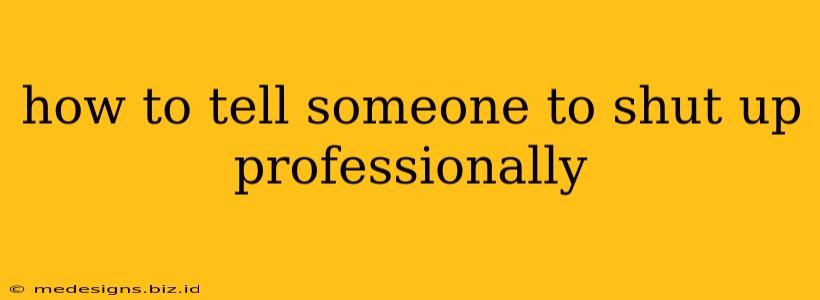How to Tell Someone to Shut Up Professionally (Without Burning Bridges)
Let's face it: sometimes, you need to politely but firmly silence someone in a professional setting. Whether it's a disruptive colleague in a meeting, a client rambling off-topic, or a subordinate making inappropriate comments, knowing how to handle these situations gracefully is crucial for maintaining a productive and respectful workplace. This guide will provide you with strategies to effectively and professionally quiet someone without damaging your relationships.
Understanding the Context
Before you even think about silencing someone, take a moment to assess the situation. Why are they speaking? Is it truly disruptive, or are they simply passionate about their point? Consider:
- The setting: A casual team meeting demands a different approach than a formal presentation.
- The individual: Their personality and relationship with you will influence your tactic. Are they generally respectful but occasionally lose track? Or are they habitually disruptive?
- The topic: Is the conversation off-topic and unproductive, or is it a legitimate discussion that's simply veering off-course?
Professional Ways to Interject
Instead of resorting to blunt commands, try these subtle yet effective methods:
-
Nonverbal cues: Sometimes, a simple, but firm, look or gesture can suffice. Try maintaining eye contact with the speaker, while subtly raising a hand to signal you'd like to speak.
-
Polite interruption: "Excuse me, I'd like to add something here," or "I appreciate your input, but perhaps we should move on to..." are effective for redirecting the conversation. Frame your interruption politely; acknowledging their contribution before redirecting.
-
Redirecting the conversation: If the conversation is straying too far, gently steer it back on track. For instance, "That's an interesting point, but let's focus on the main goal of this meeting which is..."
-
Summarizing and transitioning: Briefly summarize the main points, then gracefully transition to the next item on the agenda. This shows you've heard them, while guiding the conversation forward. For example: "So, to recap, we've covered X and Y, and now let's move on to Z."
-
Private conversation: If the situation warrants it, politely excuse yourself and the individual for a brief private chat. Explain your concerns in a calm, respectful manner.
Direct, Yet Professional Approaches (Use with Caution)
Sometimes, a softer approach isn't enough. If someone is consistently disruptive or disrespectful, you might need to be more direct. However, always maintain professionalism and respect.
- Firm but polite statement: "I understand your enthusiasm, but we're running short on time. Can we save this discussion for later?"
- Setting clear expectations: If it's a recurring problem, have a private conversation to set boundaries. Explain clearly and calmly the impact of their behavior and what you expect going forward.
Important Note: Avoid using phrases like "shut up," "be quiet," or any other condescending or disrespectful language. This will only escalate the situation and damage your professional reputation.
Documenting Issues
If the disruptive behavior continues despite your efforts, document each incident. Include date, time, location, a description of the behavior, and any witnesses. This documentation can be valuable if you need to escalate the issue to your manager or HR department.
Mastering the art of professionally silencing someone requires tact, diplomacy, and a deep understanding of workplace dynamics. By employing these strategies, you can maintain productivity, respect, and healthy working relationships.
